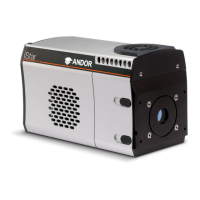2.8.5 - Dew Point
The Dew Point graph below plots the relationship between relative humidity and Dew Point at varying ambient temperature.
This can be used to calculate the minimum temperature the cooling water should be set to in order to avoid condensation.
In the relatively dry atmosphere of an air-conditioned lab, cooling water at 10ºC should not present any problems.
However, in humid conditions (such as exist in some parts of the world) condensation may occur, resulting in damage to
the head. In such conditions you will have to use warmer water (20ºC or even higher if it is very humid).
2.8.6 - Water Cooling Accessories
A chiller or a re-circulator unit can be used to achieve maximum cooling performance with the camera system. These
units circulate coolant through hoses connected to the coolant channel within the camera head.
Please refer to the New iStar specication sheets for further details and ordering information.
Figure 4: Dew point graph
2.8.4 - Condensation
Condensation may be seen on the outside of the camera body if the temperature of the liquid coolant is too low, or if the
coolant ow is too great. The rst signs of condensation will usually be visible around the connectors where the water
tubes are attached. In such circumstances, system should be switched off and camera wiped with a soft, dry cloth. It is
likely there will already be condensation on the cooling block and cooling ns inside the camera. The following actions
should be carried out:
• Camerashouldbesetasidetodryforseveralhoursbeforeattemptingtore-use
• Drygasshouldthenbeblownthroughthecoolingslitsonthesideofthecameratoremoveanyresidual
moisture
• Warmerwaterorreducedowshouldthenbeusedwhenthedeviceisstartedagain
Introduction to the New iStar

